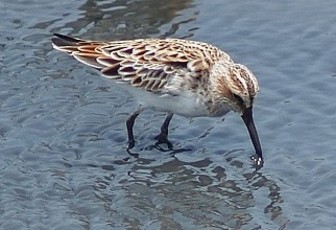Broad-billed sandpiper
This bird's breeding habitat is wet taiga bogs in Arctic northern Europe and Siberia. The male performs an aerial display during courtship. They nest in a ground scrape, laying 4 eggs.

Original source: Limicola_falcinellus_P4233431.jpg: Alnus
Author: Limicola_falcinellus_P4233431.jpg: Alnus
Permission: GNU Free Documentation License
The Broad-billed sandpiper is classified as Least Concern. Does not qualify for a more at risk category. Widespread and abundant taxa are included in this category.
The Broad-billed Sandpiper, Limicola falcinellus, is a small wading bird. It is the only member of the genus Limicola; some have proposed that it should be placed in the genus Erolia with the "stint" sandpipers, but more recent research (Thomas et al., 2004) suggests that it is should rather go into the genus Philomachus with the ruff and possibly the Sharp-tailed Sandpiper; it certainly is a fairly unusual calidrid. More
The Broad-billed Sandpiper has a large range, estimated globally at 100,000 to 1,000,000 square kilometers. It is native to Africa, Europe, Asia, and Australia, though it has been spotted in the United States and various nations in these regions to which it is not native. It prefers to live in wetlands or marine areas preferring very wet or flooded areas. It has an estimated population of 71,000 to 160,000 individuals. More
Sandpiper - The adult Broad-billed Sandpiper has gray-brown variegated upperparts with two creamy streaks on the back, underparts are white with streaked and spotted breast and neck. The head is variegated gray with a forked white eyebrow. Broad-billed Sandpiper . Bird database and its related content, illustrations and media is Copyright © 2002 - 2007 Whatbird.com All rights reserved. No part of this web site may be reproduced without written permission from Mitch Waite Group. Privacy Policy. Percevia® Registered in the U.S. Patent and Trademark Office. More
The Broad-billed Sandpiper is strongly migratory, wintering from easternmost Africa, through south and south-east Asia to Australasia. It is highly gregarious, and will form flocks with other calidrid waders, particularly Dunlins. Despite its European breeding range, this species is rare on passage in western Europe, presumably because of the south-easterly migration route. They forage in soft mud on marshes and the coast, mainly picking up food by sight. They mostly eat insects and other small invertebrates. More
Broad-billed Sandpipers in any plumage. The short legs and long tapering body are also useful. Adults in spring and juveniles in autumn tend to look contrastingly black and whte with a 'frosty' pattern on their mostly dark upperparts. Habitat Breeds on Arctic peat bogs. Occurs on passage at wetland sites including coastal lagoons, freshwater marshes and seashores. More
Broad-billed SandpiperText and Photographs by Angus Wilson Just a bit of fun! Although I was able to take extensive notes, the bird was a little too far for useful pictures. Others were able to get closer during the subsequent week and managed to get more convincing pictures. For example, check out Steve Walter's excellent video grabs. More
A few birders enjoying the immature Broad-billed Sandpiper that visited Jamaica Bay National Wildlife Refuge, Queens, New York at the end of August 1998. The bird on the far left is the Broad-billed Sandpiper while the two other peeps are Semi-palmated Sandpipers. The longer bill and more elongated body shape are clearly visible. In life, the bird appeared more black and white than these pictures suggest. More
The Broad-billed Sandpiper is one of the species to which the Agreement on the Conservation of African-Eurasian Migratory Waterbirds (AEWA) applies. Broad-billed Sandpiper Broad-billed sandpiper. Wallasea Island 04/10/08. Photo by Jeff Delve. More
The broad-billed sandpiper is an uncommon palearctic migrant. Note the distally decurved bill which has a flattened tip, best seen in upper left image. Also note the forked supercilium with a faint medial line. The images of adults were made at Pembe Abwe in October 2006. The images of the nest and chicks were taken in Norway, courtesy of Stein More
The Broad-billed Sandpiper is an uncommon, small, stint-like sandpiper reaching 18 cm in length. It is superficially like the more common Curlew Sandpiper, but smaller in size and with a smaller but distinctive, heavy bill that is longer than the head. The bill is initially straight and tapering, then downturned and flattened, remaining quite broad at the tip. This is its most important distinguishing feature. In non-breeding plumage, the forehead, crown, hind-neck and sides of neck are pale grey-brown, streaked black. More
The Broad-billed Sandpiper is one of the species to which the Agreement on the Conservation of African-Eurasian Migratory Waterbirds (AEWA) applies. References - * BirdLife International (2004). Limicola falcinellus. 2006 IUCN Red List of Threatened Species. IUCN 2006. Retrieved on 11 May 2006. More
Family : Scolopacidae
Genus : Limicola
Species : falcinellus
Authority : (Pontoppidan, 1763)
